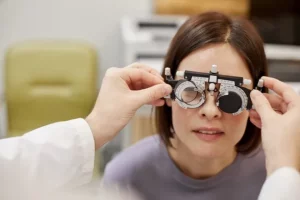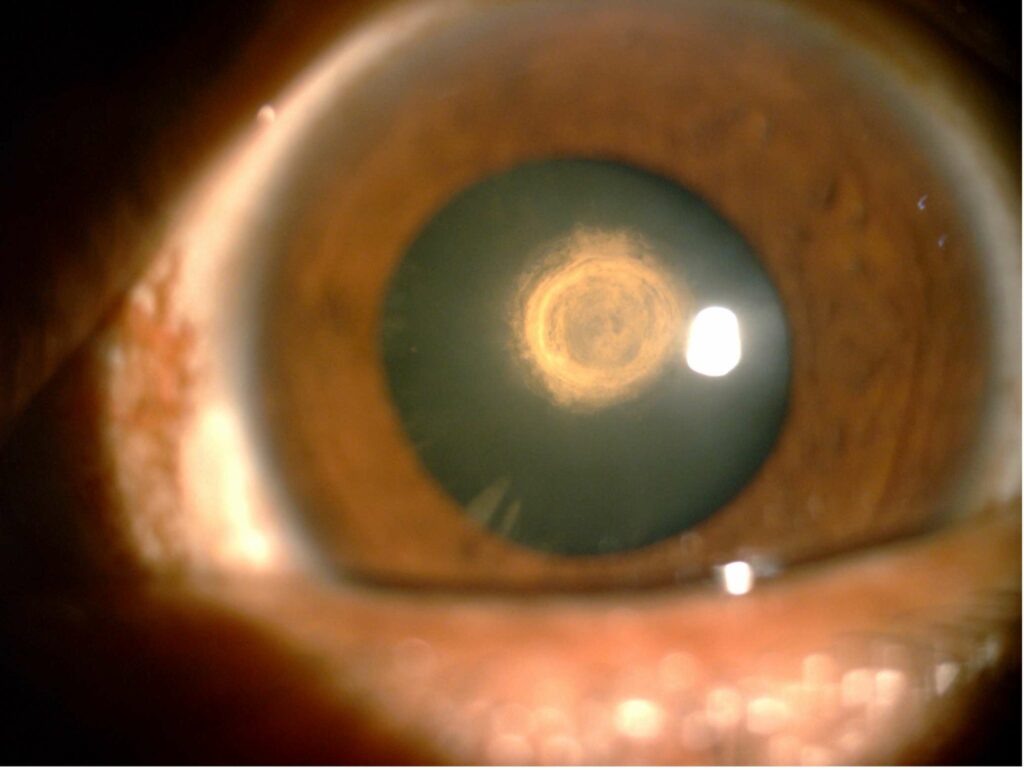If you have been diagnosed with a cataract, you may be wondering what that means for your vision. Cataracts are a common eye condition that can occur in both adults and children. In this blog post, we will discuss what a Posterior polar cataract (PPC) is, the symptoms of PPC cataracts, and how to treat them.
Contents
What Is PPC (Posterior Polar Cataract)?
 PPC (Posterior Polar Cataract) is a type of cataract that affects the posterior polar region of the lens, located at its most peripheral portion. PPC cataract is the most common type of congenital cataract, being present in up to 8% of newborns.
PPC (Posterior Polar Cataract) is a type of cataract that affects the posterior polar region of the lens, located at its most peripheral portion. PPC cataract is the most common type of congenital cataract, being present in up to 8% of newborns.
In a PPC cataract, the lens capsule is affected, causing the lens material at its center to become denser and more opaque than normal. This type of cataract usually presents itself as an oval-shaped opacity that covers the entire posterior pole of the lens (towards the back) and can cause reduced vision.
It is important to understand that PPC cataract is not an infection, but rather a developmental disorder that needs to be properly diagnosed and treated as soon as possible.
What Are The Different Types Of PPC Cataracts?
Usually, PPC cataracts can be classified into three types according to the size of the cataract:
- Conical
- Moth-eaten
- Ectatic
There are three categories of PPC cataracts, but the most common form is conical. Conical PPC cataracts are characterized by a sharp central opacity surrounded by a clear area of the lens. The other two types, moth-eaten and ecstatic, are less common but may have more severe symptoms associated with them than conical PPC cataracts.
Moth-eaten PPC cataracts are characterized by a central opacity surrounded by an area of the lens with many small opacities, while ectatic PPC cataracts are marked by irregularly shaped and large areas of the lens filled with opacities.
All in all, if you have PPC cataracts, it is important to get an accurate diagnosis so that you can receive the appropriate treatment.
How Can You Identify Posterior Polar Cataracts?
It is difficult to identify the symptoms of posterior polar cataracts yourself. Oftentimes, they are not visible to the naked eye, and can only be detected during a comprehensive eye exam.
However, there are a few symptoms that may indicate the presence of PPCs. These include:
- Blurred vision: It is common to experience blurriness or cloudy vision with PPCs.
- Halos: Patients may also see rings around lights, particularly in low-light conditions.
- Sensitivity to light: People may be more sensitive to bright lights or sunlight when dealing with these types of cataracts.
- Glare issues: Some patients will notice extra glare when in bright light.
- Trouble focusing on near objects: Finally, it can be difficult to focus on objects that are close by.
If you have any of these symptoms, it is important to get them checked out right away by a qualified ophthalmologist. They will be able to perform a detailed eye examination and confirm whether or not PPCs are present.
What Are The Causes And Risk Factors?
When it comes to PPC cataracts, there is no single cause for them. It can be caused by a variety of things, some of which include:
- Age-related changes in the eye lens
- Diabetes
- Certain medications
- Radiation exposure
- Trauma
Additionally, there could be some family history of cataracts that could increase the risk, making it more likely for someone to develop them.
It is often recommended that those at an increased risk for PPC cataracts get regular eye exams. These exams can help to detect any developing changes in the eye lens, allowing for early diagnosis and treatment.
How Is It Diagnosed?
 It is important to diagnose the presence of a posterior polar cataract as soon as possible. This can be done through a comprehensive eye exam, which includes:
It is important to diagnose the presence of a posterior polar cataract as soon as possible. This can be done through a comprehensive eye exam, which includes:
- Visual acuity test: A chart is used to measure how well you can see at various distances.
- Refraction test: This measures the amount of refractive power needed in glasses or contacts to sharpen your vision.
- Pupil dilation: Dilating drops are put in your eyes so that the doctor can see the back of the eye to diagnose any issues.
If the doctor suspects a posterior polar cataract, they will perform imaging tests such as a B-scan ultrasound or an optical coherence tomography scan (OCT). This will help them confirm the diagnosis and plan treatment if needed.
With an accurate diagnosis, your doctor can determine the best form of treatment to reduce vision loss and improve overall clarity.
What Are The Treatment Options For PPC Cataracts?
Treatments for posterior polar cataracts may include:
Surgery
Surgery is the only way to effectively treat a posterior polar cataract. The surgical procedure involves removing the cloudy lens and replacing it with an intraocular lens (IOL). Surgery is typically performed under local anesthesia, and you may have to stay in the hospital for a few days after having it done.
Medication
A number of medications can be prescribed to reduce inflammation or control pain associated with posterior polar cataracts. Your doctor will likely prescribe topical steroids or NSAIDs, as well as eye drops to reduce pain and swelling.
Laser Therapy
Laser therapy may be used to treat posterior polar cataracts. This procedure involves using a laser to reshape the cloudy lens in order to improve vision. However, results are usually temporary and need to be repeated over time in order to maintain a clear vision.
It is important to consult your doctor before beginning any treatment for posterior polar cataracts. Your doctor will be able to recommend the most effective course of action for treating your condition. Proper diagnosis and early treatment are essential for maintaining clear vision and preventing further complications.
In addition, there are some ways to help prevent the development or worsening of posterior polar cataracts. These include:
- Avoiding smoking
- Wearing UV-protective sunglasses
- Eating a nutritious diet that is rich in antioxidants
With proper treatment and prevention, it is possible to improve your vision and maintain healthy eyes. Just be sure to talk to your doctor if you think you may have a posterior polar cataract. They can help you get the care and treatment that you need.
If left untreated, posterior polar cataracts can lead to vision loss or even blindness. Don’t take any chances with your eyesight. Be proactive in getting the care you need for greater vision!
Conclusion
In conclusion, PPC cataracts are a serious eye condition that can significantly impact the vision of affected individuals if left untreated. Fortunately, there are a variety of treatments available for PPC cataracts, including surgery and medications. It is important to seek early diagnosis and treatment from an eye care professional to prevent any further damage to your eyesight.
With appropriate management and treatment, it is possible to successfully manage PPC cataracts and preserve your vision. If you have any concerns about this condition, please speak to an eye care professional to discuss the best treatment options for your specific case.
Generally, the surgery is a safe and painless procedure. Do not hesitate to reach out to us, at MantraCare we have a team of experienced eye surgeons, who will be happy to answer any questions on cataract surgery. Call us at +91-9711116605 for any inquiries.
